Cherry Barbs are peaceful, schooling South Asian delights. Unlike Tiger Barbs and some of the more aggressive fish they are related to, Cherry Barb fish are relaxed community tank residents.
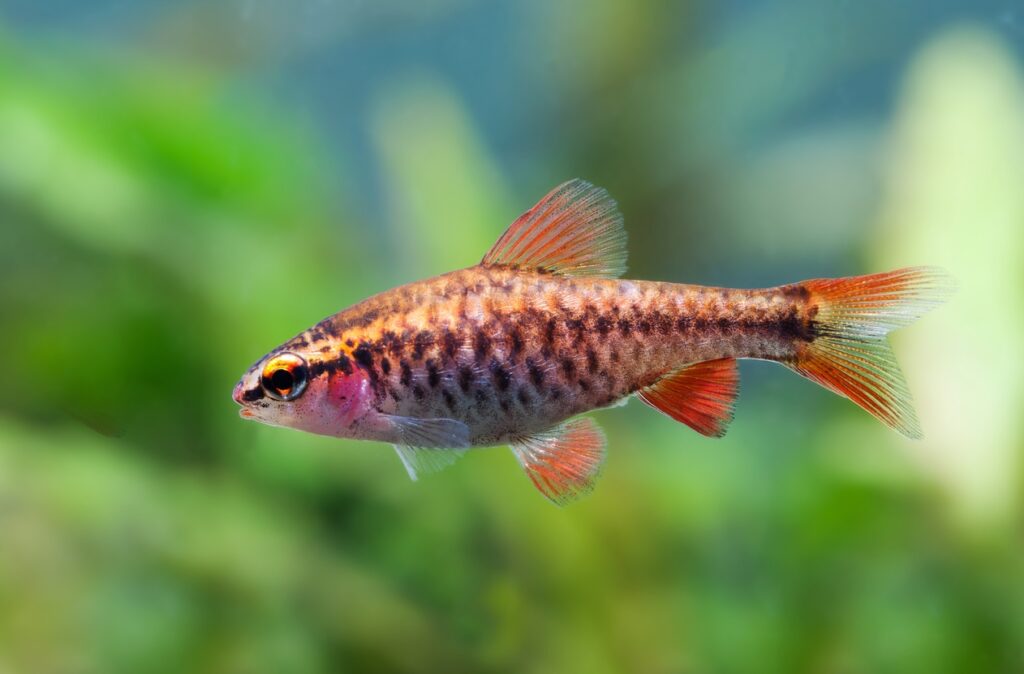
They usually won’t nip fins and can be kept in as large a group as you wish. They will even breed for you if you feed them well enough. If you are interested in learning more about Cherry Barb care then you’ve come to the right place.
Getting to Know the Cherry Barb
The Cherry Barb looks a little unusual if you are more accustomed to chunkier barbs. Tiger Barbs, Tinfoil Barbs, Black Ruby Barbs, and many of these other closely related freshwater fish tend to be bulky, wedge-shaped fish. Cherry Barbs look more like Tetra fish, with a long, slim body shape.
However, they are true Cyprinids, just like other barbs, danios, goldfish, and loaches. The Cherry Barb comes from the island of Sri Lanka, off the coast of India.
Their natural habitat is slow-moving streams and rivers in the forests of the island. However, they are all exclusively tank-raised so you will rarely find any that are wild-caught.
The Cherry Barb is an aquarium trade favorite due to the intense red coloration of the male fish. Even when he isn’t actively breeding or trying to impress a mate they retain a ruby red color that is very eyecatching.
If kept under full-spectrum lighting in a well-planted tank you may even see an iridescent green sheen if they are truly happy with their home.
Cherry Barbs are great community fish as well and rarely bother their tank mates. So let’s dive into everything there is to know about Cherry Barb care.
- Scientific Name: Puntius titteya
- Origin: Sri Lanka
- Length: 2 inches
- Aquarium Size: 10+ gallons
- Temperament: Peaceful
- Ease of Care: Very Easy
Cherry Barb Care
Cherry Barbs are radiant and even exotic-looking. But they are some of the easiest freshwater aquarium fish to care for, making them constantly in demand in the pet trade.
Cherry Barb Tank Requirements
The minimum tank size for Cherry Barbs is very forgiving. These are very small fish and they don’t need very much room. However, Cherry Barbs are schooling fish – and a single Cherry Barb will be lonely and stressed by itself.
You should buy no fewer than six Cherry Barb fish. A 10-gallon tank is an absolute minimum and a larger tank, like a 20-gallon long, is even better. 5 gallons is just barely too small since Cherry Barb males will spar with one another and need room to separate when they are done deciding who is dominant. A larger tank also means you can keep more Cherry Barb fish together.
Cherry Barb Water Conditions
Cherry Barbs are very undemanding when it comes to water conditions. While they should never be kept in polluted water they are very tolerant of elevated ammonia, nitrite, and nitrate levels. However, they will always show better color and feeding responses in good conditions. Cherry Barbs tend to really perk up after a tank clean and water change, swimming rapidly in their constant hunt for food.
Cherry Barbs aren’t picky when it comes to pH but they do prefer neutral to slightly acidic water conditions (pH 6.0-7.0). In most countries, tap water tends to be hard and alkaline (pH 7.0+). And unless you either remove these minerals or use mineral-free water, your aquarium will likely have similar conditions.
Fortunately, Cherry Barbs will still thrive in mineralized water – they are just less likely to breed. Males tend to put on radiant colors if you can reduce the hardness and pH just a little.
Feeding Cherry Barbs
As omnivores, Cherry Barbs need to eat both plant and animal matter. In the wild, they feed on aquatic insects, fish fry, algae, soft plants, mosquito larvae, and anything else they can find. So you want to give them plenty of variety in your home aquarium.
Cherry Barbs will eat flakes and micro pellets with gusto. But I recommend giving them live foods and frozen foods at times, which contain extra fat and proteins. Many live and frozen foods such as bloodworms and brine shrimp also have rich carotenoid pigments. When eaten they enhance the gold, yellow, and red tones in freshwater fish like Cherry Barbs.
If your planted tank tends to grow green hair algae your Cherry Barbs will also graze on it. They aren’t as good as a dedicated algae eater. But they will help keep some algae growth in check.
10 Compatible Cherry Barb Tank Mates
Here are 10 compatible Cherry Barb tank mates that we recommend:
Chocolate Gourami
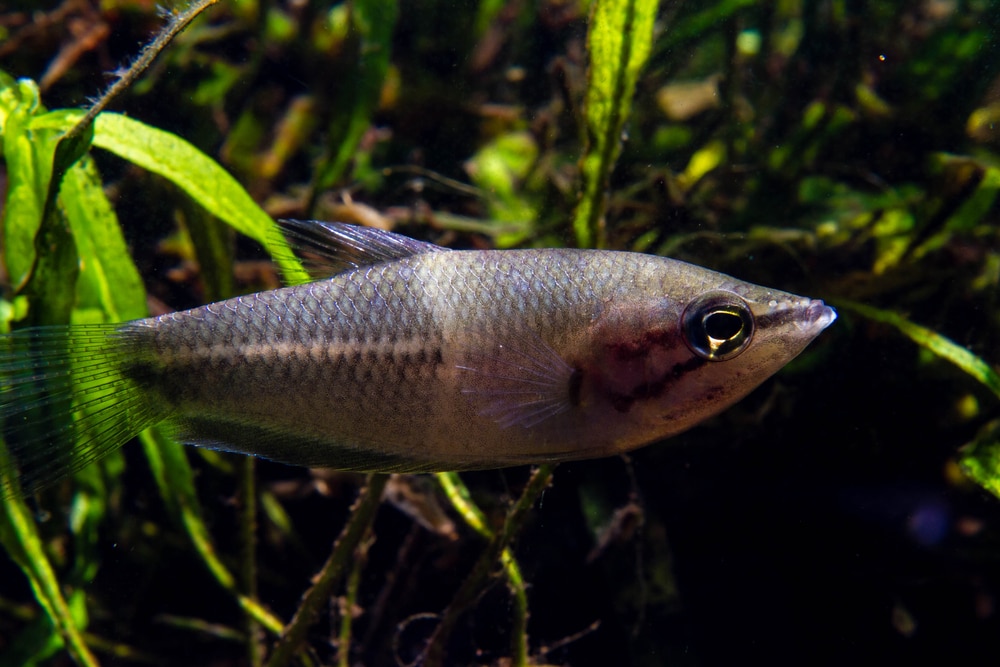
Since Cherry Barbs are rather skittish for barbs it’s good to have tank mates with a similar disposition. While many of the smaller Gourami species would work nicely the Chocolate Gourami is a fish more aquarists should consider as a Cherry Barb tankmate.
Rarely growing beyond 2 inches, this fish is a little more demanding in terms of water quality. Their natural habitat is blackwater streams where decaying leaf litter and a near-lack of dissolved minerals can drop the pH as low as 3.0-4.0.
While they do fine in pH as high as 6.0 the more alkaline conditions get the more susceptible they become to fungus, bacteria, and other opportunistic diseases.
Chocolate Gouramis have a delicate pattern of latticed shades of brown and cream. They really should be kept in heavily planted tanks where they can dart in and out of cover alongside Cherry Barbs!
- Scientific Name: Sphaerichthys osphromenoides
- Origin: Malaysia & Indonesia
- Size: 1-2 inches
- Temperament: Peaceful; Shy
Black Neon Tetra
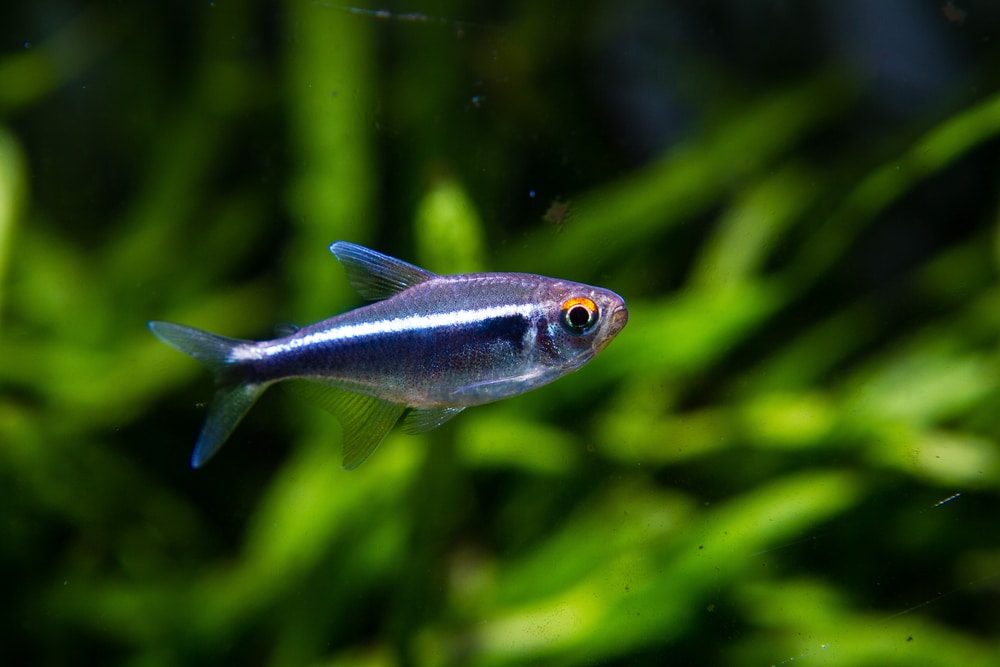
Regular Neon and Cardinal Tetras make fine tank mates for Cherry Barbs. However, if you’re looking to break up all the red you might consider the Black Neon instead.
This species is noticeably chunkier than both Neon Tetras and Cherry Barbs. They have a red eye to accent their silver and black tones. Black Neons are very common in the trade and since they have been tank bred for decades, are tolerant of a wide range of water conditions.
However, they do prefer typical Amazonian conditions: a pH of 5.5-7.0 and temperatures of 78-84F. Like Cherry Barbs, Black Neons are schooling fish and need to be kept in groups of at least 6 in order to feel secure.
- Scientific Name: Hyphessobrycon herbertaxelrodi
- Origin: Southern Brazil
- Size: 1½ inches
- Temperament: Peaceful; Schooling
Diamond Tetra
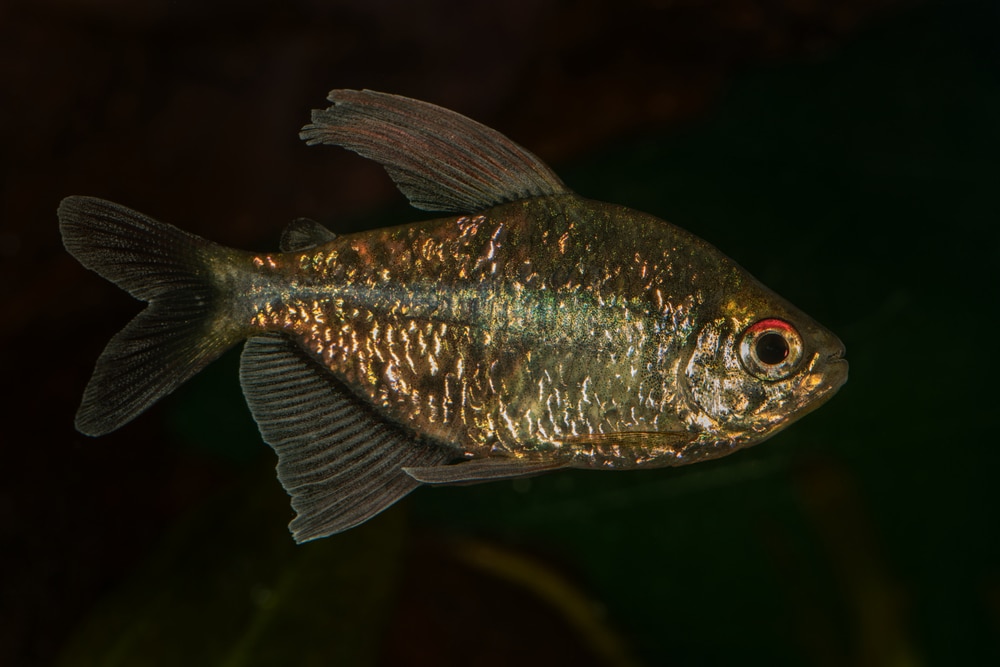
Diamond Tetras are native to a single remote lake in Venezuela. Fortunately, they are all captive-bred these days, ensuring wild populations will survive free from over-collecting.
These are some of my favorite Tetras; their subtle iridescence contains purple and green hues along with the silver tones. Diamond Tetras are similar to the closely related Black Skirt Tetra except they lack the fin-nipping habit of their cousins.
As micro predators, Diamond Tetras should be given a variety of fresh foods like daphnia and brine shrimp alongside protein-rich pellets and flakes.
Diamond Tetras are also very easy to breed; as egg scatterers, they leave their spawn among bushy plants like Guppy Grass and Java Fern.
I recommend doing so because wild populations are close to extinction thanks to overdevelopment around Lake Valencia. Fortunately, a healthy captive population may allow us to one day repopulate their home!
- Scientific Name: Moenkhausia pittieri
- Origin: Lake Valencia, Venezuela
- Size: 2 inches
- Temperament: Peaceful; Schooling
Guppies
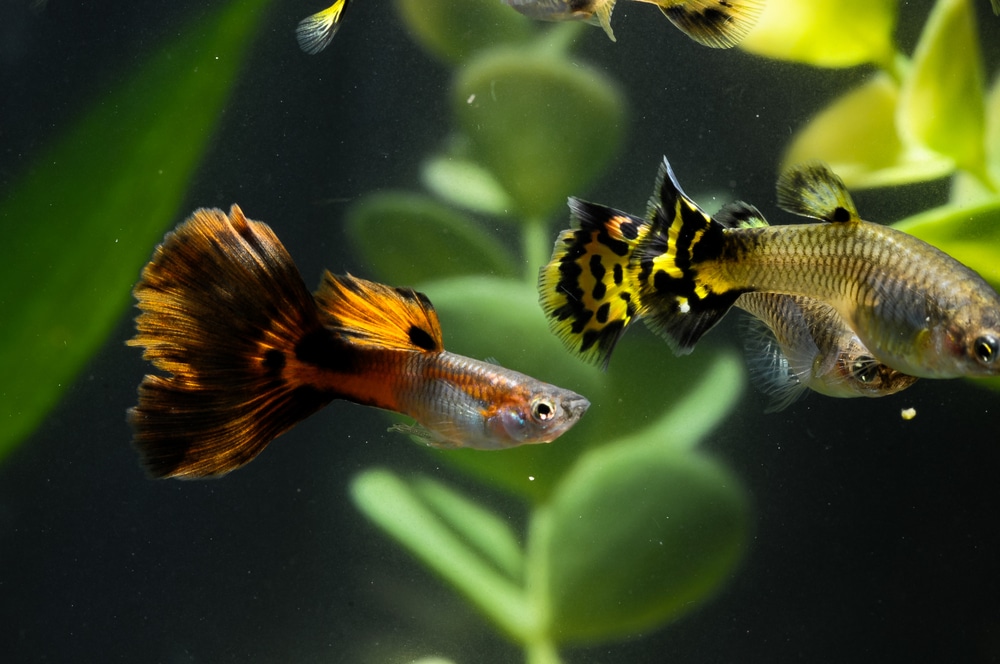
Guppies hold a special place in the hearts of most aquarists and are one of the most popular freshwater fish. Beautiful, easy to find, and incredibly easy to breed, they are hearty omnivores that can thrive in nearly any water chemistry or pH level.
However, they do prefer neutral to slightly alkaline chemistries (pH 7.0-8.0) and a touch of aquarium salt in their water. Aquarium salt boosts gill function, stimulates healthy slime coat production, and weakens many parasitic organisms.
Unlike Cherry Barbs and most of the other fish on this list, Guppies are Livebearers. Rather than scattering eggs female Guppies release large, well-developed young that quickly become free-swimming.
Guppy fry are large enough to take powdered flake and even brine shrimp nauplii. While the majority will be eaten by the other fish in the tank Guppies are so prolific a few always survive to adulthood!
- Scientific Name: Poecilia reticulata
- Origin: Venezuela
- Size: 1-1½ inches
- Temperament: Peaceful
Blue Ram Cichlid
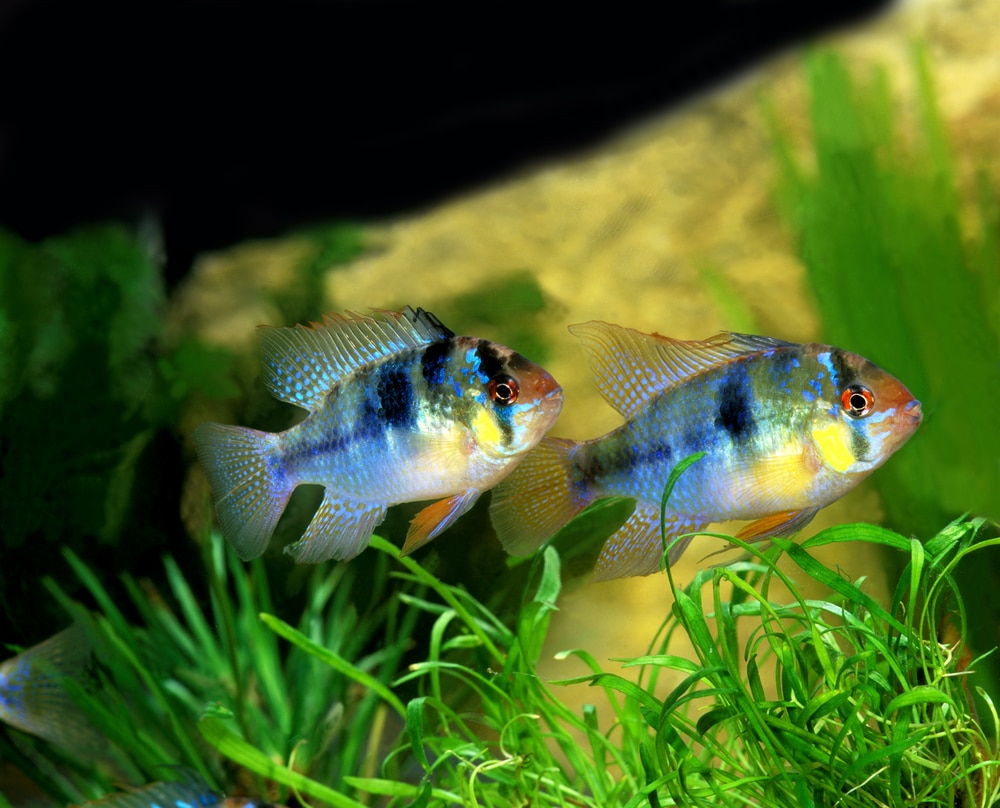
Dwarf Cichlids are excellent tank mates for Cherry Barbs because they tend to stay near the bottom while Cherry Barbs are mid to upper water column fish. And while the majority of Dwarf Cichlids are mild-mannered they can become aggressive when spawning.
The Blue Ram is no exception; while they rarely grow beyond 2 inches they can be slightly scrappy. However, they save their aggression mostly for each other and other Cichlids.
Like their larger cousins in the genus Geophagus, Blue Rams love to sift through sand for micro invertebrates and other food items. While they won’t tear up plants they will still leave little pits in the sand.
Their digging intensifies when they decide to breed, though they typically choose a hard surface to stick their adhesive eggs. Hearty meals of tubifex worms and other fatty fare go a long way towards conditioning them!
- Scientific Name:
- Origin:
- Size:
- Temperament:
Bristlenose Pleco
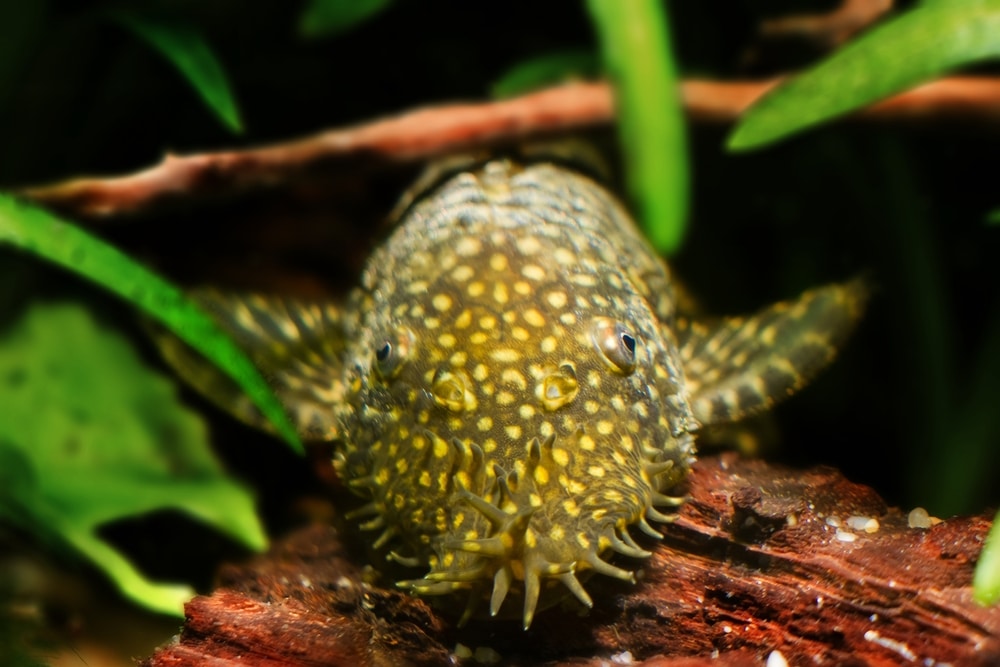
Common Plecos are generally too large, too territorial, and too hungry for all but the largest of aquariums and the most dedicated of aquarists. Instead, I recommend the Bristlenose Pleco for fish keepers with tanks 20 gallons or larger.
“Bristlenose Pleco” is a catch-all term for the many species in the genus Ancistrus. However, almost all stay 6 inches or under and have bushy bristles covering their snouts that enhance their sense of smell in dimly lit conditions. They are also incredibly hardy fish and can be bred with little effort.
They do eat algae but remember that algae rarely grows thick enough to keep a Pleco constantly fed. Nor should you force them to rely on scraps that other fish miss. Instead, you should provide them with sinking wafers rich in vegetable matter alongside blanched zucchini and other delights!
Bristlenose Plecos also need well-aged driftwood to chew on. Without it they tend to develop digestive issues and rarely do well for long.
If Bristlenose Plecos aren’t your favorite tropical fish you should also consider Dwarf Otocinclus, Rubber Plecos, and other smaller Loricariids as algae eaters for your Cherry Barbs. Considering how shy Cherry Barbs can be, these small catfish create less of a stir in aquariums 10 gallon or less in size.
- Scientific Name: Ancistrus sp.
- Origin: South America
- Size: Up to 6 inches
- Temperament: Peaceful
Chili Rasbora
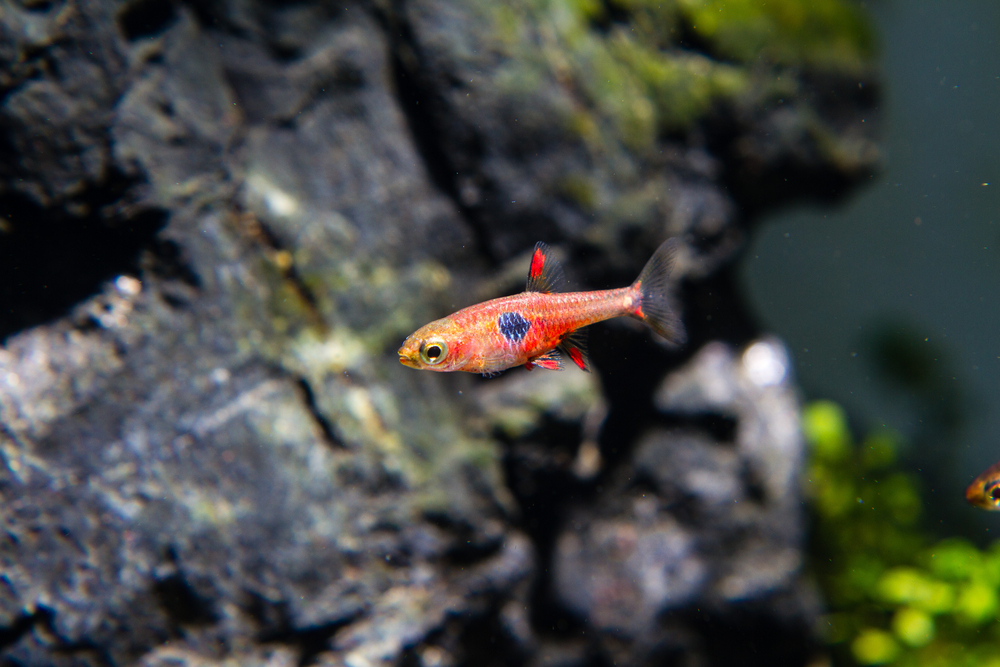
Nano fish are a great choice if your aquarium space is limited. At 1 inch as an adult, Cherry Barbs definitely qualify. However, the Chili or Mosquito Rasbora is even smaller; adults reach a maximum of ¾ inch in size!
These Indonesian natives are found in blackwater environments much like the Chocolate Gourami. Their red tones shine like tiny rubies in the tea-colored waters of their home region. Since Cherry Barbs also thrive in acidic conditions the two shy, schooling species are natural tank mates.
Tap water in many countries tends to be hard and alkaline. If your aquarium isn’t too large, you can use RO or distilled water to keep hardness levels down. And adding driftwood and Indian Almond leaves infuse the water with tannins and other agents that promote acidity.
- Scientific Name: Boraras brigittae
- Origin: Borneo, Indonesia
- Size: ¾ inch
- Temperament: Shy; Schooling
Celestial Pearl Danio
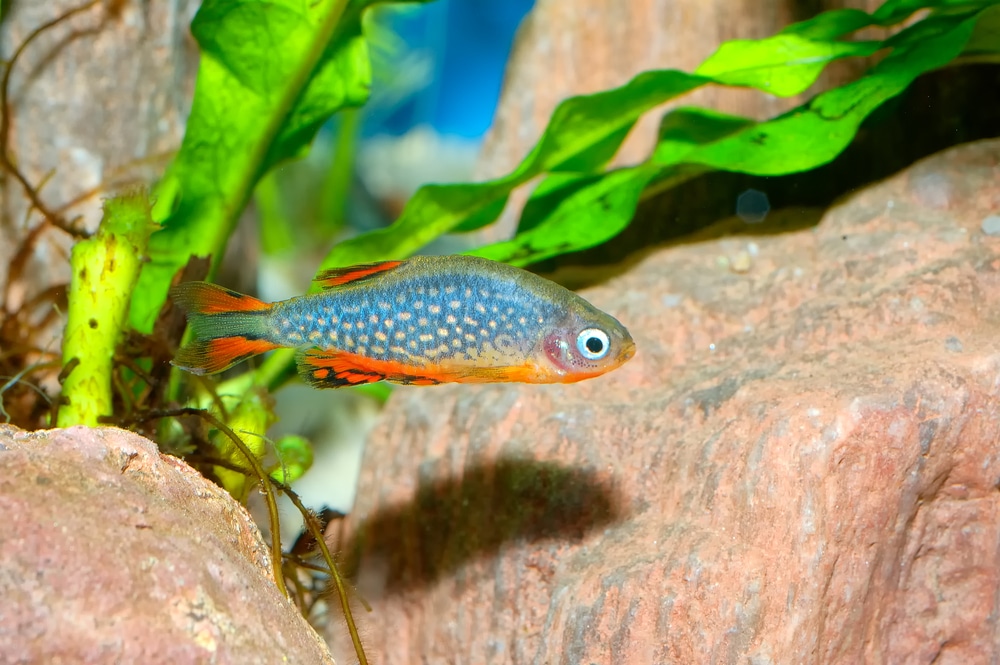
Celestial Pearl Danios are also commonly sold as Galaxy Rasboras due to their starry night pattern. Recently discovered in Myanmar in 2006, a lot is still unknown about these striking fish. However, they are becoming some of the most popular fish for planted aquascapes in recent years!
Their temperament rating may seem a little unusual but I assure you, it’s accurate. Unlike most Danios, they aren’t true schooling fish. Males set up little territories and joust for influence over wandering females.
Their fights rarely cause lasting harm but they can be exhausting for a losing male trapped in a small tank with a dominant male. Make sure you provide thick plants and other breaks in the line of sight if keeping multiple males together.
- Scientific Name: Danio margaritatus
- Origin: Myanmar
- Size: 1½ inches
- Temperament: Peaceful; Territorial
Nerite Snail
Snails are often a problem in freshwater aquariums because they can easily breed out of control. This is especially common in Ramshorn and Mystery Snails.
Nerite Snails are probably the best aquatic freshwater snail for algae control & detritus removal because they actually can’t breed in freshwater. They require brackish or saltwater for their eggs to develop so you’ll never see a population explosion in your tank!
Nerites are also efficient algae eaters and boldly patterned as well. N. natalensis is gold and black striped however red banded and even horned freshwater Nerite Snail species can be found.
Like many invertebrates, Nerite Snails prefer a neutral to slightly alkaline pH (7.0-7.5) as acidic conditions can cause their shells to deteriorate. Fortunately, Cherry Barbs are adaptable and will even breed in mildly alkaline chemistries.
- Scientific Name: Neritina natalensis
- Origin: East & South Africa
- Size: 1 inch
- Temperament: Peaceful
Bamboo Shrimp
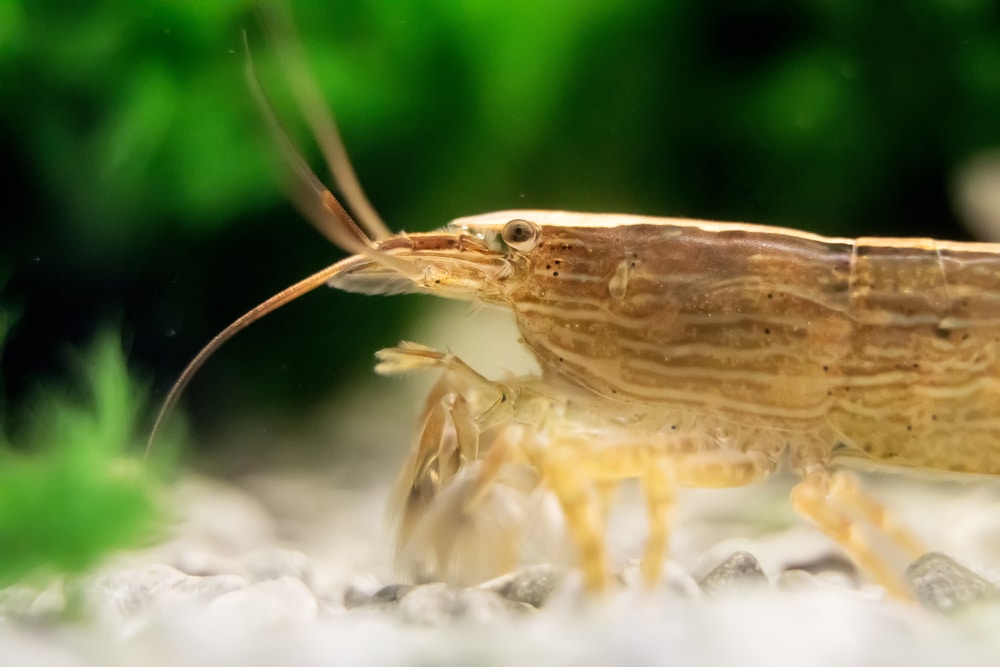
Most freshwater shrimp are safe with Cherry Barbs except for the tiny Bee Shrimp. However, I’d recommend choosing something a little larger, just in case your Barb tries to nip at shrimp when molting.
Bamboo Shrimp grow significantly larger than Cherry Barbs yet these clawless shrimp are no threat. They use fan-like projections to collect floating particles of food. Plankton, powdered flake, and daphnia are just a few items you offer these shrimp.
When hungry Bamboo Shrimp get as close as they can to a source of current (such as the filter outflow) and stretch out their limbs hoping for crumbs! They are also entirely plant-safe and peaceful towards other invertebrates regardless of size.
- Scientific Name: Atyopsis moluccensis
- Origin: Southeast Asia
- Size: 3 inches
- Temperament: Peaceful
In Conclusion
The Cherry Barb fish is an excellent beginner fish for many good reasons. They are beautiful, eat anything you offer them, and get along with any similarly sized community fish.
Few freshwater fish in the aquarium hobby are so easy to keep yet also so radiantly beautiful as the Cherry Barb.
I highly recommend trying these hardy fish for yourself if you have room for a small group.
More Frequently Asked Questions about Cherry Barb Freshwater Fish
Are you still hoping to learn more about Cherry Barb care? Then let’s address a few frequently asked questions right here.
Are Cherry Barbs Good Community Fish?
Since they are very peaceful and keep to themselves Cherry Barbs are excellent community tank fish. They have small mouths and gentle personalities so they can be kept with everything from guppies to dwarf gouramis.
How Big Do Cherry Barb Fish Get?
Cherry Barbs are smaller aquarium fish and don’t grow much larger than 2 inches. 1 ½ inches is standard for them. Males and females are close to the same size. But females tend to be both chunkier and duller in color. Male Cherry Barbs are slim but bright, making sexing these fish very simple to do.
Are Cherry Barbs Fin Nippers?
Cherry Barbs will sometimes examine long-finned, slow-moving fish like Betta fish, especially when they are introduced to the tank for the first time. But Cherry Barbs aren’t fin-nippers and will eventually lose interest in following them around. Other barbs like Tiger Barbs that are larger and more aggressive fish tend to be fin nippers.
Are Cherry Barbs Peaceful?
Cherry Barbs prefer timid fish and other peaceful tank mates. They also enjoy the company of their own kind and rarely cause trouble. Males will sometimes chase each other and any females with eggs around briefly but never do any lasting harm.

